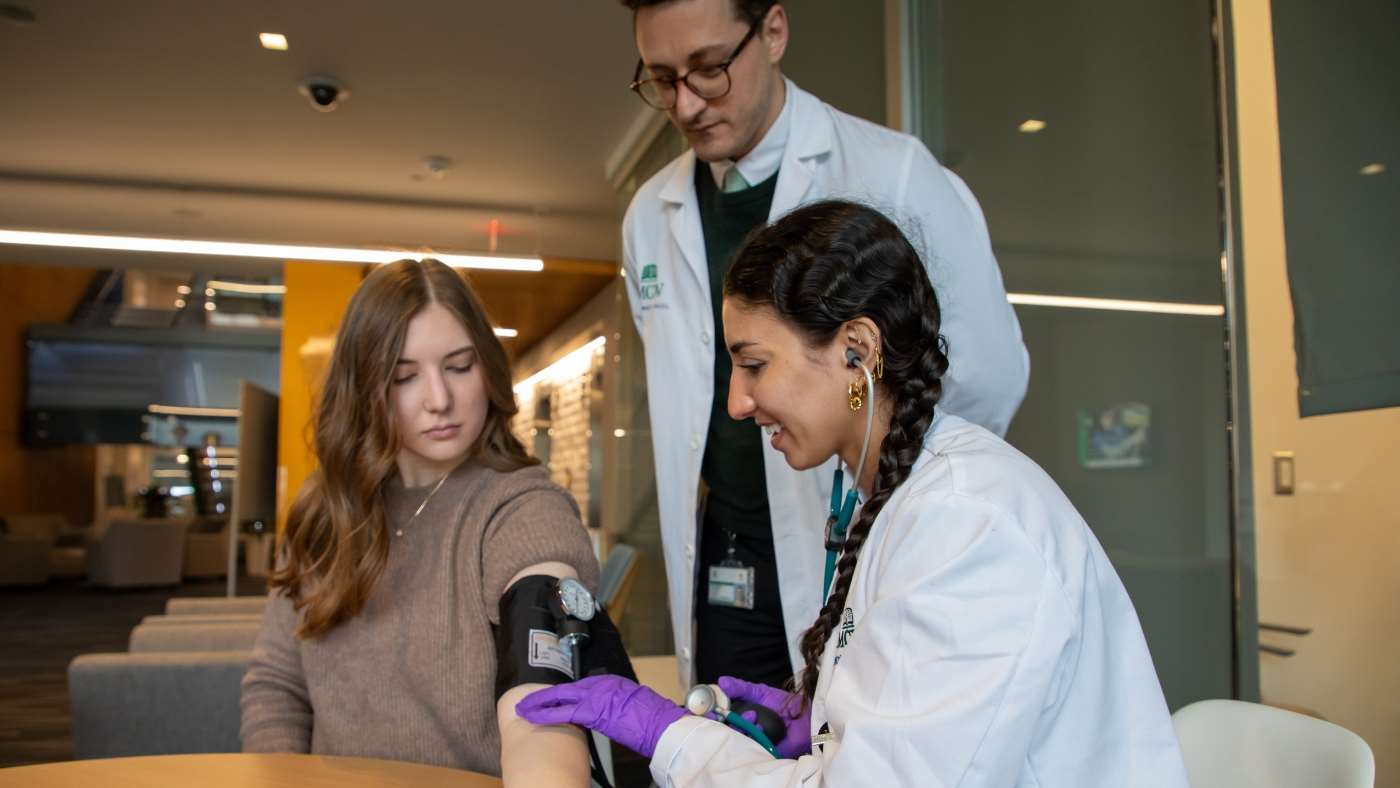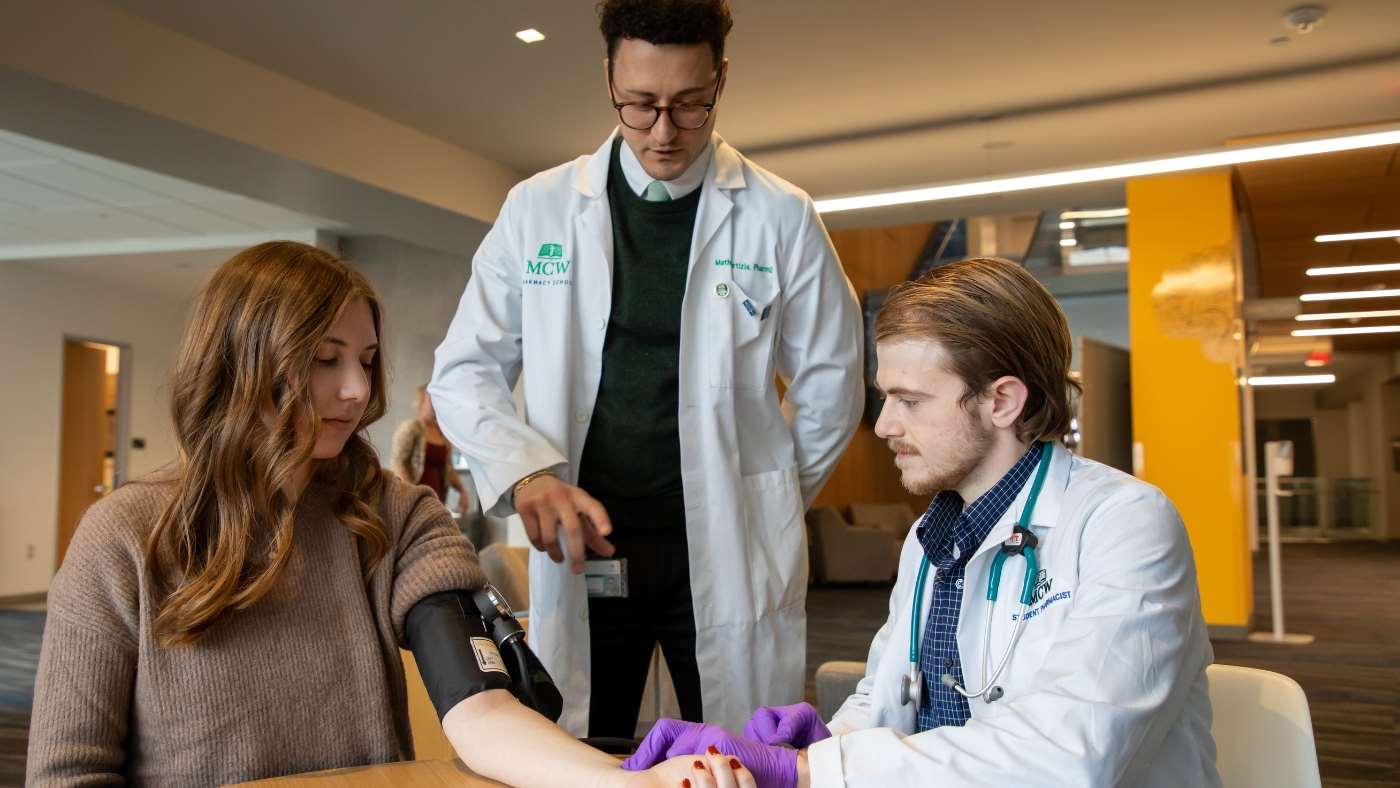MCW Pharmacy Students Utilize AMA e-Learning Module to Improve Blood Pressure Measurement Skillset

The MCW School of Pharmacy is one of the first pharmacy schools in the country to incorporate the American Medical Association’s blood pressure measurement e-learning series into its curriculum. The AMA launched the online modules in March 2021 in response to research showing medical students routinely fail on skills required to measure blood pressure. According to the AMA, struggles were related to training being “one time, textbook-based efforts that occur early in medical school and do not cover self-measured blood pressure.”
As the role of the pharmacist has evolved, it has become essential for Doctor of Pharmacy students to be properly trained in blood pressure measurement as well. Pharmacists can assist with hypertension management and addressing medication nonadherence that can make blood pressure difficult to control.
“Hypertension is known as the ‘silent killer’ because it often has no noticeable symptoms but can lead to serious health complications if untreated,” explained Mathew Letizia, PharmD, director of year one professional laboratories. “When pharmacists are collecting a blood pressure measurement, we’re also assessing whether the patient has an increased risk of developing a heart attack or stroke in the long term.”
The American Heart Association reports in 2021, heart disease and stroke accounted for more U.S. deaths than all forms of cancer and chronic lower respiratory disease combined. Approximately one in 21 U.S. deaths were due to stroke.
Pharmacists – one of the most accessible healthcare providers – are key in addressing these population health issues. The Centers for Disease Control and Prevention’s Division for Heart Disease and Stroke Prevention has recognized that community pharmacists raise public awareness, encourage lifestyle modifications, help patients take medications correctly and screen for undiagnosed high blood pressure.
During the 2024-2025 academic year, Dr. Letizia started incorporating the AMA’s “Student BP Measurement Essentials” e-learning series into his patient care lab course for first-year pharmacy students. Students completed online modules as pre-work, then Dr. Letizia worked with students to practice proper technique during lab.
“In prior years, I needed to spend time recapping the pre-work to rehash some of the concepts before we could begin practicing,” recalled Dr. Letizia. “This year after students completed the AMA modules, there were fewer questions. It allowed me to be more efficient with my teaching and spend more time practicing.”
He added that AMA’s e-learning modules included diverse imagery to represent what patients look like in 2025, a contrast to what he has encountered in textbooks or online searches.
First-year PharmD students agreed the e-learning modules prepared them for what to expect in lab.

“The AMA modules were a great mix of technical data, such as the exact numbers you would need to know, documented steps in the process to take someone’s blood pressure and practical examples – for instance how to determine if the patient is sitting correctly and where to place the equipment,” recalled Parker Reese-Grimm, a 2027 PharmD candidate.
“I’m personally a hands-on learner, so the modules gave me a good foundation and then applying that information in lab helped me realize what I needed to practice,” added Amar Joseph, a 2027 PharmD candidate.
Reese-Grimm and Joseph appreciated the videos provided in the e-module, which prepared them to identify systolic and diastolic heart sounds during lab and clinical competency exams.
 The e-learning series pointed out how to prevent technique errors during blood pressure measurement using the acronym “ABC QUES.” This stands for arm supported at heart level, bare arm for the blood pressure cuff, correct cuff size and placement, quiet and at rest during the measurement, uncrossed legs, empty bladder and supported back and feet. Straying from any of these techniques and positioning directions can cause a patient’s blood pressure to appear higher by anywhere between 2 to 40 mmHg. Other factors to document during the measurement include whether the patient has had caffeine or nicotine, exercised recently or had a full meal in the last 30 minutes.
The e-learning series pointed out how to prevent technique errors during blood pressure measurement using the acronym “ABC QUES.” This stands for arm supported at heart level, bare arm for the blood pressure cuff, correct cuff size and placement, quiet and at rest during the measurement, uncrossed legs, empty bladder and supported back and feet. Straying from any of these techniques and positioning directions can cause a patient’s blood pressure to appear higher by anywhere between 2 to 40 mmHg. Other factors to document during the measurement include whether the patient has had caffeine or nicotine, exercised recently or had a full meal in the last 30 minutes.
“You don't really think about how challenging noticing all the details can be when you’re with the patient, like crossed legs and back placement,” said Joseph. “It can also be odd to ask if they need to empty their bladder or requesting that they stop talking to allow for an accurate reading – but those are things you don’t want to overlook.”
Throughout the patient care lab course, pharmacy students routinely practice the clinical skillsets they will utilize during rotations at various practice sites. Dr. Letizia explained that it takes repetition to ensure students can accurately remember all of the required steps and proper techniques for proper blood pressure measurement. If students are uncertain about any step of the process, he said they can efficiently reference that particular section of the e-learning module to re-learn or refresh their memory.
“I struggled with the stethoscope placement for a while but went back to the e-learning resources and really nailed down exactly where to put it so I wouldn’t struggle with that in the future,” said Reese-Grimm.
“These modules allowed me to enhance my teaching delivery, and they improved the student experience, so they were better prepared for lab,” said Dr. Letizia. “I saw their confidence improve and that’s the goal of my class. I want students to leave my class confident and prepared to practice these skillsets during their rotations.”
View the AMA's student blood pressure measurement learning series

